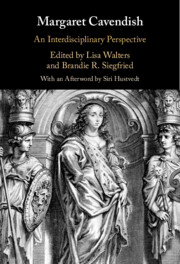Book contents
- Margaret Cavendish
- Margaret Cavendish
- Copyright page
- Contents
- Illustrations
- Notes on Contributors
- In Memoriam
- Acknowledgments
- Introduction
- Part I History of Science
- Part II Philosophy
- Chapter Five Cavendish’s Philosophy of the Passions
- Chapter Six Cavendish, Philosophical Letters, and the Plenum
- Chapter Seven Cavendish’s Philosophical Genres in Philosophical and Physical Opinions and the Question of Hierarchy
- Part III Literature
- Part IV Politics
- Part V New Directions
- Afterword
- Chronology of Works by Margaret Cavendish
- Select Bibliography
- Index
Chapter Five - Cavendish’s Philosophy of the Passions
Theory and Practice
from Part II - Philosophy
Published online by Cambridge University Press: 28 April 2022
- Margaret Cavendish
- Margaret Cavendish
- Copyright page
- Contents
- Illustrations
- Notes on Contributors
- In Memoriam
- Acknowledgments
- Introduction
- Part I History of Science
- Part II Philosophy
- Chapter Five Cavendish’s Philosophy of the Passions
- Chapter Six Cavendish, Philosophical Letters, and the Plenum
- Chapter Seven Cavendish’s Philosophical Genres in Philosophical and Physical Opinions and the Question of Hierarchy
- Part III Literature
- Part IV Politics
- Part V New Directions
- Afterword
- Chronology of Works by Margaret Cavendish
- Select Bibliography
- Index
Summary
This chapter provides one of the first accounts of Cavendish’s theory of the passions in her later works of natural philosophy, mainly the Philosophical and Physical Opinions (1663) and her Grounds of Natural Philosophy (1668). We argue that reading Cavendish’s philosophy in light of a Stoic-inspired model of causation highlights what is most original and distinctive about her theory of the passions. We analyze Cavendish’s ideas against the backdrop of her theories of occasional and principal causes, and highlight significant differences between Cavendish’s philosophy and the then-popular Cartesian account of the passions. We also examine how her philosophical ideas are put into practice in her dramatic work, “The Unnatural Tragedy” (1662). We maintain that the dramatic genre enables Cavendish to demonstrate how sociable passions might be communicated through sympathy, and unsociable passions discouraged through antipathy. In light of both the theoretical and practical aspects of her philosophy, we conclude that Cavendish stands as a significant innovator among theorists of the passions in the mid-seventeenth century.
- Type
- Chapter
- Information
- Margaret CavendishAn Interdisciplinary Perspective, pp. 83 - 97Publisher: Cambridge University PressPrint publication year: 2022
- 2
- Cited by

